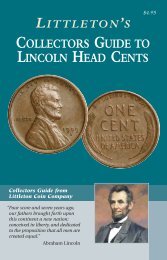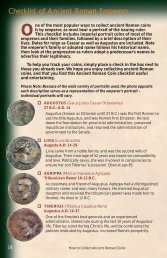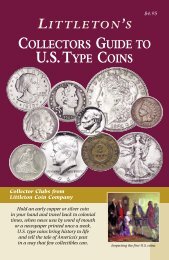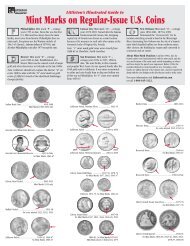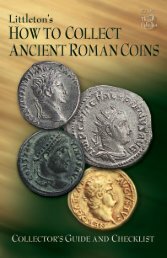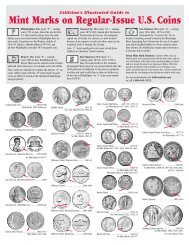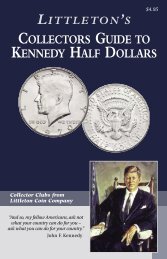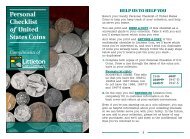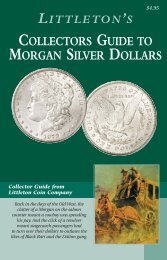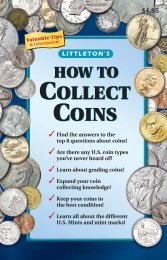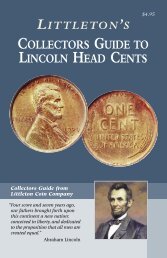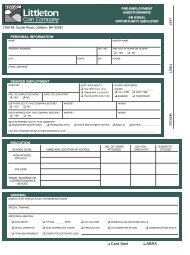Collecting Paper Money - Littleton Coin Company
Collecting Paper Money - Littleton Coin Company
Collecting Paper Money - Littleton Coin Company
You also want an ePaper? Increase the reach of your titles
YUMPU automatically turns print PDFs into web optimized ePapers that Google loves.
paper money glossary<br />
{<br />
34<br />
Microprinting is<br />
used to foil<br />
counterfeiters. On<br />
the Series 2004 $20,<br />
it is found below<br />
the Treasurer’s<br />
signature.<br />
IN GOD WE TRUST was<br />
added to the back<br />
of U.S. paper<br />
money in 1957<br />
|<br />
The engraved<br />
obligation –<br />
along with a<br />
warning against<br />
counterfeiting –<br />
on a Series 1869<br />
$1 Legal Tender<br />
(United States)<br />
Note.<br />
www.littletoncoin.com<br />
Greenback Originally known as a Demand Note. Issued in<br />
1861, it was the first note to have a green reverse or back,<br />
establishing a tradition that exists today. Green ink was<br />
originally used as an anti-counterfeiting measure, because<br />
early cameras and film could not reproduce it. Today,<br />
Greenback is a common term for any U.S. paper currency.<br />
Horseblanket A popular nickname for U.S. large-size notes<br />
(see page 19).<br />
Large-Size Refers to U.S. paper money that measures<br />
73 ⁄8˝ x 31 ⁄8˝, issued 1861 to 1928.<br />
Legal Tender (or United States) Note The longest-lived<br />
type of U.S. paper money, Legal Tender Notes were<br />
authorized by the U.S. government in 1862, and last issued<br />
in 1969.<br />
Microprinting The tiny printing (letters can be six- to<br />
seven-thousandths of an inch high) found in various areas<br />
of some U.S. paper currency (see page 30). Since most<br />
photocopiers and scanners cannot capture such small<br />
detail, this is an effective anti-counterfeiting measure.<br />
Military Payment Certificates Commonly known as<br />
MPCs, issued between 1946-1973 by the U.S. armed forces<br />
for use overseas by service personnel.<br />
National Bank Note Also known as National Currency.<br />
Most extensive paper money series in the nation, issued by<br />
government-chartered national banks in the U.S. from 1863<br />
to 1935, and secured by government bonds.<br />
National Motto “In God We Trust,” the national motto of<br />
the United States; added to the back of paper currency in 1957.<br />
9 Obligation Legal Tender issued by the federal<br />
government is a promissory note; the government is<br />
required, or obligated, to honor it as legal currency.<br />
The actual written obligation (current notes state<br />
THIS NOTE IS LEGAL TENDER FOR ALL DEBTS, PUBLIC AND<br />
PRIVATE) appears on each note. The location and<br />
wording varies by series and type.<br />
Obsolete Bank Note <strong>Paper</strong> money issued<br />
prior to 1865; often used interchangeably with<br />
Broken Bank Note; however, many banks that<br />
issued notes became National Banks or liquidated<br />
(obsolete banks), but did not fail (broken banks).<br />
Obverse The front side of paper money; the preferred<br />
term is Face.<br />
Overprint Refers to adding the serial number, Treasury<br />
seal, and Federal Reserve District Seal and number to the<br />
front of paper currency; the overprinting is done in green<br />
ink after the black portion has been printed.<br />
{littleton coin company



